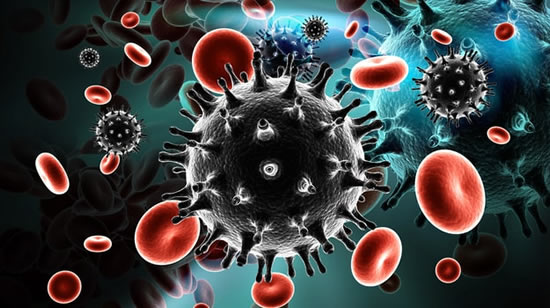South African HIV Patient Was a Natural Laboratory for SARS-CoV-2 Mutations
Published: Jun 10, 2021 By Gail Dutton

An immunocompromised patient in South Africa became a veritable COVID-19 variant laboratory as the virus mutated more than 30 times in 216 days of her infection, according to recent, not-yet-peer-reviewed research paper published in medRxiv.
The new properties developed by the SARS-CoV-2 virus during its incubation in this HIV patient’s body enabled it to increase in strength, resist certain vaccine compounds and block some COVID-19 therapeutics.
In all, there were 13 genetic changes related to the virus’ spike protein and 19 additional genetic changes that further changed its behavior. Some of these changes became persistent, then declined as other mutations became more prevalent. Consequently, the variant that emerged was better able to evade the body’s immune system.
“Unlike many of the other reported cases, virus evolution was not driven by the receipt of immune-based therapies (convalescent plasma or monoclonal antibodies),” according to researchers from the University of KwaZulu-Natal in South Africa, who authored the report. Instead, they suggest the viral evolution “may have been driven by selective pressure from an impaired neutralizing antibody response.”
For example, the E484K mutation in the spike receptor binding domain emerged very early in the course of the infection – 19 days after the first onset of symptoms. Typically, this mutation occurs late in the course of COVID-19. It is associated with resistance to class 2 neutralizing antibodies.
Then, at day 34, the Y144 deletion emerged and persisted until day 106. It is in one of the recurrent deletion regions in neutralizing antibodies that are associated with neutralizing antibody escape. As the virus persisted, the E484K mutation was replaced by mutations at sites in the receptor binding domain that were associated with resistance to class 1, 2 and 3 neutralizing antibodies.
Several additional research reports document prolonged infections in patients with immunosuppressed patients, such as those with organ transplants. Most, however, were resolved in about one month. None-the-less, many showed intra-host evolution of the SARS-CoV-2 virus that often is characterized by mutations in the spike glycoprotein.
Because the SARS-CoV-2 virus persists longer in HIV or other immunocompromised patients than in otherwise healthy people, this suggests immunocompromised populations could be a long-term source of transmission, as well as of viral mutation. This could reprioritize the need to vaccinate and treat immunocompromised patients early against COVID-19, as one way to slow the emergence of new variants, according to the South African researchers.
The work was part of a 300-person study documenting the effect of the SARS-CoV-2 virus on HIV patients.
The woman, a patient in her late 30s from the KwaZulu province of South Africa, had an advanced stage of HIV and had failed antiretroviral treatment. She had received neither clinically-induced immunosuppression or neutralizing antibody-based treatment for COVID-19.
She was hospitalized September 2020 after experiencing sore throat, cough, and dyspnoea 12 days earlier. She also had chronic asthma (treated with inhaled budesonide and salbutamol) and in 2006 experienced one episode of tuberculosis. Treatment was a six-day course of dexamethasome and oxygen (via face mask). After nine days, she was discharged.
The researchers report the patient was asymptomatic on day 34, but complained of chest tightness on day 71. A chest X-ray showed non-specific perihilar infiltrates, so she was treated as an outpatient for Pneumocystis jiroveci pneumonia. On day 106 she was tired, and on day 190 she was asymptomatic again. At that point, her antiretroviral medication was changed a fixed-dose combination of tenofovir, lamivudine, and dolutegravir. On day 206, she achieved HIV viral load suppression.
Throughout all this, her PCR tests were always positive for the SARS-CoV-2 virus. Data indicates she carried mutations seen in both the UK strain (now dubbed Alpha) and South Africa strain (dubbed Beta) of the virus.
As of the most recent posting (May 2021), Health Department of the KwaZulu-Natal province of South Africa said the province accounted for 20% of all cases of COVID-19 – the second-highest incidence rate – in the nation, and the fourth highest in terms of COVID-19-related deaths. The incidence rate is increasing as the cooler autumn months begin in the southern hemisphere.
At the same time, South Africa has the largest HIV program in the world. In 2019, approximately 14% of the South African population was living with HIV – nearly 20% of those age 15 to 49 years – according to Statistics South Africa. KwaZula-Natal typically is mentioned as the hardest-hit province.
Given this reality, the researchers conclude, “If persistent infection does occur more frequently in the context of HIV, it may provide justification for prioritizing people living with HIV for COVID-19 vaccination.”
###
Contact:
The BioSpace Content Team
news@biospace.com
Source: https://www.biospace.com/article/south-african-hiv-patient-was-a-natural-laboratory-for-sars-cov-2-mutations/
"Reproduced with permission - BioSpace"
BioSpace
For more HIV and AIDS News visit...
Positively Positive - Living with HIV/AIDS:
HIV/AIDS News
|